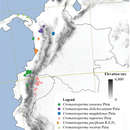Description
provided by Phytokeys
Tree 6–18 m tall, 15–22 cm diam.; young twigs and petioles sparsely covered with white-yellow appressed hairs 0.3–0.5 mm long. Leaves: petioles 3–6 by 1.5–2 mm, often with warts extending up primary vein; axillary buds densely covered with white-yellow appressed hairs 0.3–0.5 mm long; lamina narrowly elliptic to elliptic, 14–24.5 by 6–10 cm (index 1.6–3.1), chartaceous to subcoriaceous, mid-dark brown above, lighter below, glabrous above, sparsely covered with white-yellow appressed hairs 0.3–0.5 mm long (particularly on veins) below, base obtuse-acute (narrowly cuneate), apex acuminate (acumen 5–15 mm long), primary vein not conspicuously grooved, 1–2 mm wide at widest point, secondary veins (5–)7–9(–11), intersecondary veins occasional, distance between from 5 mm at the base to 30 mm closer to the apex, angles with primary vein 40–50° at the base to 50–70° closer to the apex, not branching, forming distinct loops in the apical half-two thirds, smallest distance between loops and margin 1.5–4 mm, tertiary veins percurrent with significant reticulation. Inflorescences of single flowers solitary or clustered in groups of 2 (or more), produced from leafy twigs or leafless branches; peduncles of two internodes, the second 1.2–4 by 1 mm (in flower), approx. 2 by 2 mm (in fruit); pedicels 28–47 by 1 mm at the base, 1–1.5 mm at the apex (in flower), 40–55 by 1.5–2 mm at the base, 2–2.5 mm at the apex (in fruit); peduncles and pedicels rather densely covered with white-yellow appressed hairs 0.3–0.5 mm long; two lower bracts (one on each internode), the apical one persisting later into flowering, 1–1.5 by 0.7–1 mm, broadly ovate, obtuse, soon falling off, rather densely covered with white-yellow appressed hairs 0.3–0.5 mm long; upper bract broadly to narrowly ovate, 1–3.5 by 1–2 mm, obtuse, persistent, densely covered with white-yellow appressed hairs 0.3–0.5 mm long; closed flower buds depressed ovoid; flowers green maturing to yellow in vivo, brown outside and black inside in sicco; sepals free, ovate, appressed, 3–4 mm long, obtuse, occasionally persistent on less mature fruit, densely covered with white-yellow appressed hairs 0.3–0.5 mm long; outer petals ovate to broadly so, 10–15 by 9–11 mm, inner petals ovate, 10–16 by 7–8 mm densely covered with white-yellow appressed hairs 0.3–0.5 mm long; receptacle ovoid to depressed ovoid; androecium 3–5 mm diam., stamens 1–1.2 mm long, connective appendage ca. 1 mm wide; gynoecium 1.5–2 mm diam., carpels 0.5–0.6 mm long, glabrous. Monocarps 10–20 (fully ripe fruit not observed), black in sicco, ellipsoid or narrowly so, 27–28 by 11–12 mm, with an excentric apicule (obvious only in immature fruit); stipes 17–19 by 1.5–2 mm; fruiting receptacle broadly ovoid, 4–5 mm diam.; monocarps and stipes sparsely covered with golden appressed hairs <0.1mm long or glabrous, receptacle often sparsely covered with white-yellow appressed hairs 0.3–0.5 mm long. Seeds ellipsoid to narrowly so, ca. 17 by 7 mm, dark brown and wrinkled, raphe sunken, encircling seed diagonally.
- license
- cc-by-3.0
- copyright
- Michael D. Pirie, Lars W. Chatrou, Paul J. M. Maas
- bibliographic citation
- Pirie M, Chatrou L, Maas P (2018) A taxonomic revision of the Neotropical genus Cremastosperma (Annonaceae), including five new species PhytoKeys (112): 1–141
- author
- Michael D. Pirie
- author
- Lars W. Chatrou
- author
- Paul J. M. Maas
Distribution
provided by Phytokeys
Colombia (Antioquia, northern and western foothills of the Cordillera Occidental; one specimen potentially representing the species from Riseralda [Betancur & al. 33011]).
- license
- cc-by-3.0
- copyright
- Michael D. Pirie, Lars W. Chatrou, Paul J. M. Maas
- bibliographic citation
- Pirie M, Chatrou L, Maas P (2018) A taxonomic revision of the Neotropical genus Cremastosperma (Annonaceae), including five new species PhytoKeys (112): 1–141
- author
- Michael D. Pirie
- author
- Lars W. Chatrou
- author
- Paul J. M. Maas

